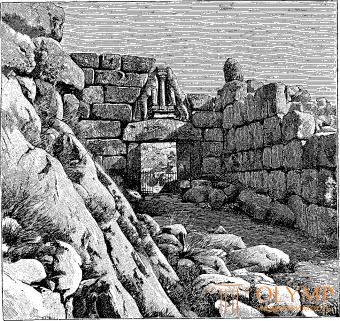
Following the ancient worlds of the art of the Nile Valley and Mesopotamia, each of which was completely independent and self-sufficient, an important third world should be considered, encompassing the countries whose shores are washed by the eastern Mediterranean: Syria, Asia Minor, the Aegean islands and eastern coast of Greece. The embryos of art grown on the soil of these countries were transferred from one coast to another on the wings of the sea wind, fertilized by a variety of Egyptian and Old Babylonian influences, but in some respects they developed themselves under the life-giving rays of the local sun.
Simultaneously with the heyday of the Egyptian kingdom in the new period and the secondary ascent of the ancient Roman culture in Babylon under the rule of the Cossets, in the 2nd millennium BC. Oe., along the shores and on the islands of the Aegean Sea, culture flourished, which since the time of Schliemann’s excavation in Mycenae, it has been accepted, for the sake of brevity, to call Mycenaean. Mycenaean art, therefore, is more ancient than Assyrian, Phoenician, and Asia Minor times of Homer. Above, in the section devoted to the prehistoric era, we have already pointed to even more ancient stages of the development of art, as it is, for example, after the excavations of the city of Troy. The pre-Nicene period of Aegean art on the island of Crete, which became famous after the discovery by Evans of one figurative inscription on Cretan stones, as well as on some other islands of the Aegean Sea, gradually turns into Mycenaean. The antiquities of the island of Thera, related, as has been proven, by the end of the 3rd millennium BC. Oe., namely the remnants of wall painting with colors of linear ornaments and motifs of the vegetable kingdom and fragments of clay vessels with colorful ornaments on them, are already close to the works of Mycenaean art. Two urns, carved from green marble and shaped like pile structures, one rectangular from the island of Milos (Munich collection), the other round from Amorgos, represent the rich spiral decoration of the Mycenaean Bronze Age. Angularly stylized nude female figures with arms crossed on their breasts, found in the tombs of Amorgos and other islands, belong already to the Mycenaean era. But the blooming sometimes Mycenaean art considered 15001200 years. BC e. By this time, the existence of the main points of this art, Tiryns and Mycenae, in that part of the Peloponnese, which later became known as Argolid, and the existence of Troy on the coast of Asia Minor belong. From 1893 we learned that of the cities excavated at the site of ancient Troy (in Hissarlik), not the second from the bottom, as Schliemann suggested, but only the sixth was the creation of Mycenaean culture and, therefore, the "sacred Ilion" of Homer. But also in Knossos on Crete, even in the Athenian Acropolis, found the remains of buildings and works of art belonging to this period of the flowering of Mycenaean life; the graves, rich in works of applied art, were opened under the archaeological spurs not only in Mycenae, Navplia, Amiklah (Vafio) in the Peloponnesian peninsula, but also in Spata, Menedi, Eleusis in Attica, in Orchomen in Boeotia, in Domini (Volo) in Thessaly, as well as on Crete, Rhodes, Cyprus and other islands. The most curious remains are dug and described by Schliemann in the years 1870-1890. The enterprise started by him continued, and, moreover, more systematically and scientifically, V. Dörpfeld at different points, Chr. Tsunta - in Greece. Mycenaean, prephinic and even more ancient prehistoric tombs of Cyprus were described by M. Onefash-Richter; remnants of the Mycenaean colony in Lower Egypt were dug up in Coluna by Flanders Petri. The wreckage found by Schliemann in Troy, with the exception of those that had to be given to Constantinople, is in the Berlin Museum of Ethnology, while the treasures found in Greek soil are in the main Athenian museum.
The bearers of the Mycenaean culture were the inhabitants of Greece before the "Dorian relocation", which occurred in 1100 BC. e., - predecessors, and perhaps the ancestors, at least along the lateral line, of the later Hellenes, who called them pelasgas. In Homer's poem, they are the "light-burnt, curved-eyed" Achaeans who destroyed the holy city of Troy. Homer, like the Nibelung singers, sang the heroic deeds of the generations that lived thousands of years before him. The art that he attributed to them, or even to their gods, in detail about their shields, cups and other things, in any case, was before his eyes. That among these objects were works that had a thousand years ago, therefore, works of the Mycenaean era, it seems possible, because besides them Homer mentions contemporary works of Phoenician origin.
Mycenaean culture belongs to the Bronze Age. She did not like the Homeric Iron Age, bronze weapons and tools were known. Even the iron rings that served for decoration appear only at the very end. This is a prehistoric era only to the extent that the art of poetry is not history. However, Evans proved that the ancient, perhaps, actually still ideographic figurative inscription, found by him in Crete and by its linear appearance approaching a letter, is the only one of its kind between works of the entire area of Mycenaean culture; it remains only to expect what results will lead to further discoveries or decryption of the found characters.
The megalithic method of building the city walls of this area can also be called belonging to the Bronze Age. Each city hill contained stones that could be inserted into its walls. Cyclopean walls, that is, randomly composed of rough stones, hewn only from the outside, were joined, especially when the gate was built, sometimes the correct rows of hemmed quadrilateral slabs, and in Mycenae themselves, along with this clutch, later, polygonal type of construction, in which the wall was made up of irregular multi-faceted stone blocks, carefully hewn and fitted one to another until completely correct closing of the grooves. This polygonal method was unknown in Egypt and Mesopotamia, and in Greece it became common in the construction of city walls.
Perrot sees the construction of the gates in such city walls as follows: initially the gates were made of two stone pillars, set obliquely towards one another and converging with their upper ends so that these pillars, together with the threshold, formed a triangle; further development of this kind of construction are two vertical posts, interconnected at the top of a massive stone slab, above which, to reduce pressure, a triangle similar to the above is arranged. A fine example of such structures is represented by the famous Lion Gate in Mycenae, in which we see a horizontal stone beam lying on two almost vertical stone pillars and a triangle reducing pressure, the latter filled with a stone boulder with a heraldic style between the two lions that stood up on hind legs (fig. 194). This column can be considered the prototype of all Mycenaean columns. It is thicker at the top than at the bottom, stands on a narrow and low round foot and is decorated with a capital, consisting, in the upward direction, of a convex ring, a notch, a considerably convex pillow and a quadrangular slab (abacus). On this plate are four circles, on which rests the second, also a quadrangular plate, which completes the capital. This stone column is obviously an imitation of the wooden columns of the Mycenaean palaces. Four circles represent the ends of round beams. Similarly, the thinning downwards, peculiar only to the Mycenaean stone columns, is explained by their origin from wood. The legs of the tables and chairs are now given such a look.

Fig. 194. The Lion Gate in Mycenae. From the photo
For the history of architecture, corridors and cameras in the city walls of Tiryns are indicative. The corridors are equipped with a cornice and covered with lancettached false arch; doors of the same shape as described above lead to the cells that served as storerooms, arranged on the sides of the corridor and covered in the same vault as he. Where the cameras are destroyed, daylight penetrates through the pointed openings of the corridor doors, which thus seem to be a gothic gallery from a distance.
The city palaces were investigated during the excavations so that it is possible to recognize not only their plan, but also the method of construction, as well as the decoration of the walls. The building materials for them were flagstone, air-dried brick, and wood. It is noteworthy that the sixth Mycenaean city, Troy, is an example of a transition to the construction of stone. Burnt brick was still unknown at that time. In Tiryns and Mycenae, only the bottom of the walls and the bases of the columns hidden in the stone field consisted of stone; the upper parts of the walls with fan-shaped nests in them for the ends of wooden beams were made of unbaked bricks; pillars are made of wood with capitals and flooring above them, wall pilasters located opposite them and a roof covered with rammed clay. The walls needed lining, and wooden and metal boards were used for it, and in some places also precious stone, but most often a layer of lime, which was easily mined from the limestone-rich mountains of Greece.
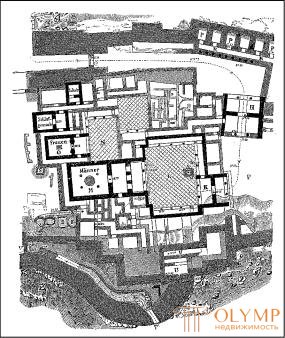
Fig. 195. Plan of the Tiryns Palace. According to Schliemann and Dörpfeld
The walls of the palace in Tirinfe are open on a very large space (Fig. 195). To the large, open courtyard adjacent to the south are two massive gates, the same in plan (K and H). Those and others form on both sides, front and rear, porticos, opening outwards by passages between two columns and between the projections of the side walls of the gate itself (antes). These are real Greek cuts, which we will meet in the heyday of Hellenic art. Through the smaller gate ( K ) we enter first of all into a rectangular courtyard surrounded by galleries on the columns ( Z ), on it one can still discern the place of the altar of Zeus located here (A). To the north side of the courtyard adjoin the canopy of the main building of the male megaron (M). Three doors, one next to the other, lead to the inner front hall, which opens with doors without a gate to the megaron itself - a large rectangular hall, in the middle of which is a large hearth, which is still surrounded by four pillars of the columns that supported the roof. How it was arranged in this inner peace, how the light passed into it and how the smoke of the hearth came out of it remains an unresolved, controversial issue. Those researchers who found similarity, albeit very distant, to Egyptian temples throughout this building, tend to think that here too there existed a somewhat higher average space with a ceiling supported by wooden columns and with side openings for light. The room for women (O) is a smaller repetition of the hall of men. The palace of Mycenaean rulers is recognized as a prototype of the Greek temple. Perrot and Sipieu even published a device of the Mycenaean beam coatings, which represented all the details of the structure of the Doric beams, with the only difference that the latter are not stone, but wooden. If we adhere only to immutable facts, then we can get an idea of the form of Mycenaean wooden columns of the type of stone, preserved in the ornamentation, such as, for example, the column on the Lion Gate, on which lie stone beams, apparently imitating wooden.
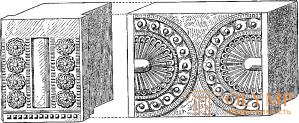
Fig. 196. Alabaster frieze of the Tiryns Palace. By Perrot and Shipie
From the wall decorations of the Mycenaean palaces preserved significant remains. Alabaster frieze from the halls of the hall of men in the Tiryns Palace (fig. 196) is among the plastic works of this kind. Its individual parts represent the ornament, which is generally often found in the works of Mycenaean art and characteristic of it. The middle piece of frieze, partly seated in a vertical direction with rosettes, adjoins on the right and left along an oblong piece, horizontally ornamented by two semi-oval, the middle of which is occupied by a fan-shaped palmette, and the edge consists of a series of heart-shaped spirals. Perrot and Shipier, with whom Noack also agreed, believed that this frieze disguised the wooden beams of the megaron's canopy in such a way that pieces with rosettes fell on the protruding tips of the beams and marked them. Thus, this frieze should be viewed as a prototype of the later Doric triglyphic frieze. Several backing parts of the frieze with fan-shaped ornaments in the semi-valleys would then correspond to the metopes. The frieze ornaments somewhat rise above the blue glaze of its background, so that the “blue friezes” with which, according to Homer, the palace of Alkinoi was decorated, cannot be considered an invention of the poet.
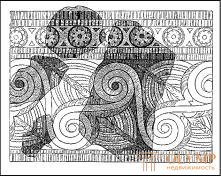
Fig. 197. Pattern in the form of a tape, forming a spiral. From tirinfskih frescoes. By Perrot and Shipie
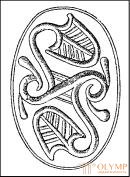
Fig. 198. Cretan carved stone. According to evans
Numerous fragments of lime plaster of the walls indicate the extent to which they were painted. The coloring was made directly on the raw lime, and therefore, here for the first time in the history of art there is a real fresco painting. Paints, slightly rising their contours over a white or blue background, were exclusively red, yellow and blue. Among the images to which we will return later, the most important is the bull catching. Among the ornaments there are often repeated on Mycenaean works of art from other materials and other techniques, for example, such: a peculiar mesh with rhombic loops and round eyes of carved outlines; spiral and wavy lines of every kind; curls facing one another and constituting heart-shaped figures; heart-shaped leaves in one another and real branches of plants, framed by figures in the form of bubbles. Particularly curious ornament in the form of a tape, forming a spiral, which is framed on the edge of a strip of rosettes; by its nature it belongs to the type of nets of spirals found on the ceilings of the Egyptian tombs of the New Kingdom (fig. 197). Obviously, this pattern, which we find also in Orchomen, only in an even more ancient form, is borrowed directly from Egyptian art.
How such an ornament could be brought from across the sea gives us an explanation of one carved stone found by Evans on Crete, decorated with a pattern in the form of a similar connection of spirals, but only with a median leaf of a different shape (Fig. 198).
The tombs, preserved from the Mycenaean era, its content even richer homes. Of these, the most interesting are in Mycenae. The tombs look like mines, at the inner side of the Lion's Gate, older than the domed tombs in the lower city. For the history of architecture, the first are important only because of the same stone lining of their walls, which we meet in the European Bronze Age. The tombs are decorated with standing stone slabs (stelae), which, if they are female tombs, have no decorations, and if for men, they are ornamented with relief patterns of meander lines and images of the carriage of the deceased on a military or hunting chariot. The oldest are the tombs, in which the men's remains were found with gold masks, bibs, belts and luxuriously decorated weapons, and the women - in magnificent gold tiaras, crowns and pendants; The vessels placed here are gold or silver. The tombs, in which the men's masks and women's earrings and bracelets were not found, belong to a later time; all the jewelry and weapons are simpler here, and the vessels are mostly clay.

Fig. 199. The Atreus Treasury Column in Mycenae. According to Zibel

Fig. 200. Part of the ceiling of the dome-shaped tomb in Orchomen. According to Brunn
Dome-shaped tombs are lined with earth outside and are round, similar to bee hives premises with a false vault, formed by protruding one above the other horizontal rows of stones. An open passage in the hill leads to the entrance portal.The most famous and interesting of the tombs of this genus is the structure, to which Pausanias, the Greek writer of the times of the Roman Empire, gave the name "Atreus' Treasury". From the rich decoration of the triangle, arranged above the gate to reduce pressure, only fragments of two side columns carved from a dark green stone have survived; they are in the Mycenaean, Athenian, London and Munich collections (Fig. 199). Their form is the same as the form of the column on the Lion's Gate. They thin down, and at the top of them lies a small capital, consisting of a round pillow and a cornice under it, decorated with a ring of leaves. The core of the column is wrapped in a horizontal direction in rows of bands, like ribbons, forming zigzags and decorated with wavy curls. Inside the tomb, in which "the walls and the ceiling merge among themselves", was studded,how can it be concluded on the holes and bronze nails still preserved in the walls, metal decorations, probably bronze rosettes. It is 15 meters high and the same in diameter. In another domed tomb, opened in Mycenae by Mrs. Schliemann, an ornamental column is curious, representing the Mycenaean thinning downwards and at the same time equipped with Doric flutes. Mycenaean columns are considered "true protodoric columns" also in the form of their capitals. The dome-shaped tomb in Orchomen, in Boeotia, which Pausanias took for the treasury of Minius, is famous for the pattern of a network of spirals on its greenish slate ceiling. In this pattern, the spirals constantly alternate with fan-shaped palmettes, and the middle fields are bordered by a strip seated with rosettes;A strictly maintained distinction between edges and internal fields can be viewed as an important step in the further development of Egyptian ceiling decorations (Fig. 200).

Fig. 202. Trojan lead idol. By Perrot and Shipie
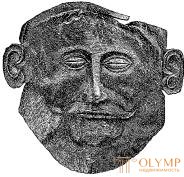
Fig. 201. Mycenaean golden burial mask. According to Brunn
Sculpture and painting of the Mycenaean art world in general is difficult to consider separately from its artistic and craft industries. Art and artistic craft were one more whole. However, from this it is possible to exclude some works of sculpture and painting, not related to the objects of everyday use. As for the Mycenaean sculpture, its monuments are primarily masks of the dead in ancient tombs, carved out of gold leaf. No matter how they were made, either mechanically or by hand, they tightly embraced the faces of the dead and represent the first experiments of sculpture from nature (Fig. 201). From the number of finds in the Mycenaean Kremlin, noteworthy are: life-size beardless head, from a porous stone, with a well-preserved color, partly reminiscent of a tattoo; sculptures of two life-size lions, now headless, at the main gate in Mycenae. Compared to the sluggish, common forms of the aforementioned tomb reliefs, they represent a step forward in terms of carefully depicting muscles and revitalizing surfaces, as much as was available to more mature Mycenaean art. Numerous ugly little idols of baked clay, stone, ivory and bronze, found in the area of Mycenaean art, for the most part have the character of works of prehistoric era already familiar to us. In most cases, they can be viewed as objects of Aryan origin and local work. However, it is not always possible to single out works from other places or performed under foreign influence from these finds. A small lead idol from Troy (Fig. 202), depicting a naked woman with a swastika on her belly, most researchers recognize, like all the images of Ishtar (Astarte, or Aphrodite), for a thing of Babylonian origin, and Solomon Reinac points to this idol as evidence that all of this kind of figurines of Aryan-European origin. If this Trojan lead idol stands on a rather low rung of the art development ladder, then at its end it is necessary to place a female bronze figure, 19 centimeters high, located in the Berlin Museum; this figure, like many others like it, was probably found in Crete. Her flowing dress, her hair braided and sprawled on her back, a full bust with rounded shapes and a wide swing of her free posture make an impression of a strikingly mature work (fig. 203).

Fig. 204. Warriors on the Mycenaean grave. According to Tsunte (1896)

Fig. 203. Mycenaean bronze female statuette. By Perrot and Shipie
Fragments of wall murals first of all introduce us to the Mycenaean painting . But in the paintings with figures, it is limited to black outlines and the use of three colors: yellow, red and blue. In view of the antiquity of that stage of the development of art to which these paintings belong, it goes without saying that all the figures in them are depicted in profile and without observing the perspective. The aforementioned image of a bull catching comes from a palace in Tiryns: a wild animal with a short head and horns jutting out ahead turned to the left and quickly runs. A man on whom, in Mycenais, there is nothing but an apron and straps on his legs, grabbed the bull by the horns with his right hand and the animal rushes with it with all his might; the background of the picture is blue, the bull is yellow with red spots. In one of the side extensions of the Mycenaean Kremlin a remarkable fragment of the picture was found, which depicts people with donkey heads, going one after another and carrying a long pole. This picture refers to the embryonic pore of Greek mythology, which Milchgefer called polydemonism. Mycenaean half-humans can be considered the ancestors of Greek satyrs. Like satire, they are humorous. Another piece, depicting two women, in a carved toothed frame, gives the impression of a real easel painting, although it is written in raw lime. By the same kind of paintings should be counted painting on a stone slab, which found Conce in one dome-shaped tomb among the so-called folk graves in Mycenae. On the middle field of the picture there are five soldiers in helmets and with shields, moving to the right and spearing arrows (Fig. 204). And here we find the outlined figures on a white background, illuminated only with yellow, red and blue colors. Looking ahead, we must also mention the figure on the "vase with the soldiers" found in Mycenae (Fig. 205); on it, in addition to the six retreating warriors and the weeping woman standing behind them, five more heroes are depicted, attacking with raised spears - figures completely similar to the soldiers drawn on the above-mentioned stela, not only in dress and weaponry, but also in form. As in all works of Mycenaean art, these figures are slim, with thin legs, long necks and noses. Therefore, the stone and the vase we are talking about confirm the local origin of the Mycenaean style. The most mature of the surviving works of Mycenaean art belong, however, to carving on stone, work in gold, and artistic pottery.
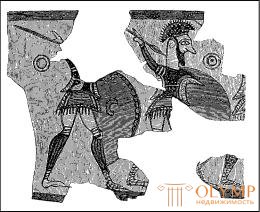
Fig. 205. A fragment of the Mycenaean vase with the image of soldiers. By Furtwengler and Leshke
Stone carvings left samples of engraved seals and jewelery. Since they were found for the first time on the Greek islands, they were called island islands. From these ancient monuments, beginning with the Cretan ones, one can trace the transition from Aegean to Mycenaean art, from figurative letters to letters, from simple ornaments and images of animals and people to hunting and war scenes, from the old belief in demons to the Greek heroic myth. As for the forms, in the images cut on seals and gems that served as decorations, we find, in the period of maturity of the Mycenaean art, well understood, only too long figures with a thin, aspen waist, lively and expressive movements that usually occur during all forms of this art; in the costume of the depicted men we see aprons, similar to bathing pants, in the costume of women - constantly repeating wide, flowing robes; the tendency to symmetry is often noticeable, which here, as elsewhere, directly led to the heraldic style. Two oval stones for gold rings, found in the ancient Mycenaean tomb, belong to the most valuable monuments of this kind. One shows a deer hunt, the other a battle (Fig. 206, f). On a stone seal from Crete, a demon with a donkey's head is presented, bearing on a pole thrown over a shoulder the booty of hunting (f), - pendant to human figures with a donkey's head, which we saw in Mycenaean frescoes. The image on the gold ring, representing a group of women with flowers in their hands under a tree, has not yet been fully explained ( h ).

Fig. 206. Mycenaean monuments engraving on stone and gold products. According to Brunn (f, i), Perrot, Shipie (a, b, d, e), Reichel (h) and Schuchardt (c, d, c)
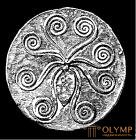
Fig. 207. Polyp. Mycenaean gold plaque. According to Schuhardt

Fig. 208. Mycenaean gold plaque in the form of a leaf. According to Schuhardt
Works of goldsmiths provide an opportunity to visually trace in the Mycenaean culture all the stages of the development of ornamentation and plastics. From the smooth tiaras of the Dominican art of Troy, which did not differ in their particularities by the variety of forms, to the gold cups of Vafio it was necessary to go a long way. Embossed gold leaf objects found in the ancient tombs of Mycenae are ornamented with convex concentric leafy wreaths with rosettes in the form of stars and narcissus flowers, with forked and spiral lines in various variations, sometimes they are bent in three and four knees. Another feature of Mycenaean art - ornamental motifs, taken from the local nature. The main role is played by a polyp, or sepia (Fig. 207); his eight twisting tentacles are so suited to the style of spiral ornament that they can probably be considered to have given rise to this style. Karl Tyumpel pointed out that sepia was considered sacred in animal demonology, and with good reason he saw in it the ancestor of Lerney hydra. From the vegetable kingdom borrowed the form of ornaments in the form of fan-shaped leaves (Fig. 208) and wreaths of leaves, both the simplest and most complex outlines. On other objects made from sheet gold, there are figures of whole animals - deer, cats, swans, eagles, sometimes in pairs, like coats of arms. The head of a single gold stud represents the whole figure of a well-formed stone sheep. The fantastic creatures of Egypt and Asia Minor sometimes join the representatives of the local fauna. Sphinxes (see fig. 206, e ) and griffins are not rare. Sometimes there are also human figures, more often than others - a rather poorly modeled figure of a naked woman surrounded by flying pigeons: this is the goddess Ishtar (Astarte, Aphrodite); her nudity, according to Reichel, is not at all a symbol of femininity, but is connected with a myth, probably of even pre-Semitic origin, about the journey of this goddess to hell for the redemption of souls. Therefore, objects of this kind should be considered amulets accompanying the dead to the grave and providing an afterlife for them (see. Fig. 206, c). Elements of most of these ornamental motifs are also found on gold and silver vessels from shaft-like tombs. Only the decoration of one piece of silver cup strongly deviates from the ornamentation of this kind. The relief on it depicts the defense of the city, under the walls of which archers and slingers fight (see. Fig. 206, d). The mountains, the trees, the fortress with their small mutual connection in relation to the landscape are reminiscent of works of late Assirian art. However, the long figures of the combatants, in relation to their heroic nudity, the proportionality of the members of the body and the liveliness of the movements have nothing like themselves in the art of that era. Dagger blades must be considered the most precious works of art found in the most ancient mine-tombs. In the so-called fourth tomb found 5 bronze blades with drawings, lively and naturally made gold and silver notch. On one of these blades, on the one hand, there is a lion pursuing an antelope, and on the other, five hunters fighting a lion (see fig. 206, i ). The main thing from the fifth tomb is a blade with gold and silver display on both sides, depicting animals like cats attacking ducks (see. Fig. 206, k). The action takes place on the river, in the waters of which fish float, and flowers grow on the shore; but neither papyrus nor lotus are seen among them. This image generally resembles to some extent the painting on the floor in Tell el Amarna, but, as Schuhardt noted, the Egyptian dagger from the tomb of Queen Ahotep resembles this dagger only in that it is also ornamented. These metal inlays are very important because they give an idea of the technique and the language of the forms with which metal works made famous by Homer, or especially the famous shield of Achilles, sung in the "Iliad", were performed or at least conceived. So, for example, we can easily imagine a golden vineyard with silver vines and blackened clusters using the technique of flat drawings on Mycenaean blades. Finally, two cups (see Fig. 206, a and b) from the dome-shaped tomb in Amiklah (Vafio) are extremely curious. They are covered with pictures of knockout work, superior in power, naturalness and vitality of the image depicted everything that was created by art before the blooming pores of Hellas. A scene of catching wild or semi-wild bulls is presented. In one picture, it happens calmly: a naked peasant tied a roaring bull by the left hind leg, which obediently allows to behave. The drawing of the second cup, on the contrary, is full of life and movement. One of the bulls resists, and it had to be covered with a net; the other bull throws one of the catchers from its back with a strong jump, and lifts the other on its horns. It is safe to say that neither the contemporary Egyptian art nor the modern Mesopotamian art were able to depict a profile in the side view as faithfully and precisely as the villager depicted falling from the back of the bull; and at the same time - what aversion to any schematization of nature, how much thoroughness in the transfer of the muscles of the human body and animals, how much flair for the delights of various motives of movement!
The works of Mycenaean art ceramics, after we became acquainted with the magnificent works of goldsmithing, give us very little new. Since Furtwangler and Leschke published their classic work Mycenae Vases in 1886, the number of newly found vase fragments at least doubled, but, in essence, they only confirmed the history of the development of Mycenaean pottery, sketched by these scholars. Mycenaean vases painted with matte paints on a glossy or non-glossy background belong to a more ancient period than those painted with lacquer paints. These latter constitute a feature of all Greek art, including in it the Mycenaean. Vases painted with matte paints, as a rule, are molded, and painted with lacquer paints - all are made on a potter's wheel. Clay vessels painted with lacquer paints can be divided into four classes, of which the first two, developing in parallel, are older than the other two. The first class vessels are completely covered with black lacquer paint, according to which the painting is made with matt white and dark red colors. On vases of the second class, the background is white or dark brown, and the drawings are filled with dark brown and lacquer paint and are touched with white here and there. The vessels of the third class indicate a significant step forward made in the pot industry. Their clay is better, the smooth surface glitters with warm yellowish tones, the decorations are painted with lacquer paint, which accepts all sorts of shades from yellow-brown to black-brown, and the details are covered with white paint. In the fourth grade, which already goes beyond the limits of the Mycenaean culture, the yellow background is a more dull or greenish tone, and in the ornamentation, filled with lacquer colors, there is again red.
As for the content of the ornamentation of the first two classes, the Mycenaean style is already fully developed in it; along with patterns consisting of spirals and other winding lines, we find motifs borrowed from the local seaside nature, such as, for example, waves, fish, starfish, akalefy, shells, corals, polyps (Fig. 209); the latter are found especially often, and their tentacles in all possible bends, which can only be thought up, cover the sides of the vessels; vegetative motifs are also used — ivy sprouts, tree branches, lily flowers, parts of a palm tree, which the Mycenaean navigators, of course, had to meet in one of the areas of their culture. In the style of the third class, along with all these ornaments already mastered by the Mycenaean goldsmiths, are linear patterns, the origin of which is mistakenly attributed to weaving, and more often depicted bird figures, four-legged, less often people, like in the vase described above with soldiers, but never There are vultures, sphinxes, lions and Egyptian lotus flowers. Reinac noticed that animals of heraldic style, which fall into ornamentation of fourth-class vessels, are by no means borrowing from the East, as it was believed before.
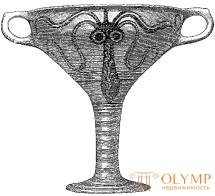
Fig. 209. Clay vase from Talis. By Furtwengler and Leshke
The value of Mycenaean ornamentation for the history of the development of ancient art is mainly explained by the studies of Richl. In any case, this scientist is absolutely right, recognizing the special development of the vegetative ornament by the independent artistic work of the Mykene, in which they have the right to be considered the predecessors of the Hellenes. Indeed, for the first time in Mycenaean art, we meet with freely climbing antennae of plants; for the first time we see patterns made up of continuously curving and interrupted plant stems, which is alien to all Oriental art, but characteristic of all Hellenic and post-Hellenic (Fig. 210).
The lot that the Dorian relocation prepared for Mycenaean art is particularly clearly reflected in the painting on the vases. Mycenaean style is replaced
Что бы оставить комментарий войдите
Комментарии (0)